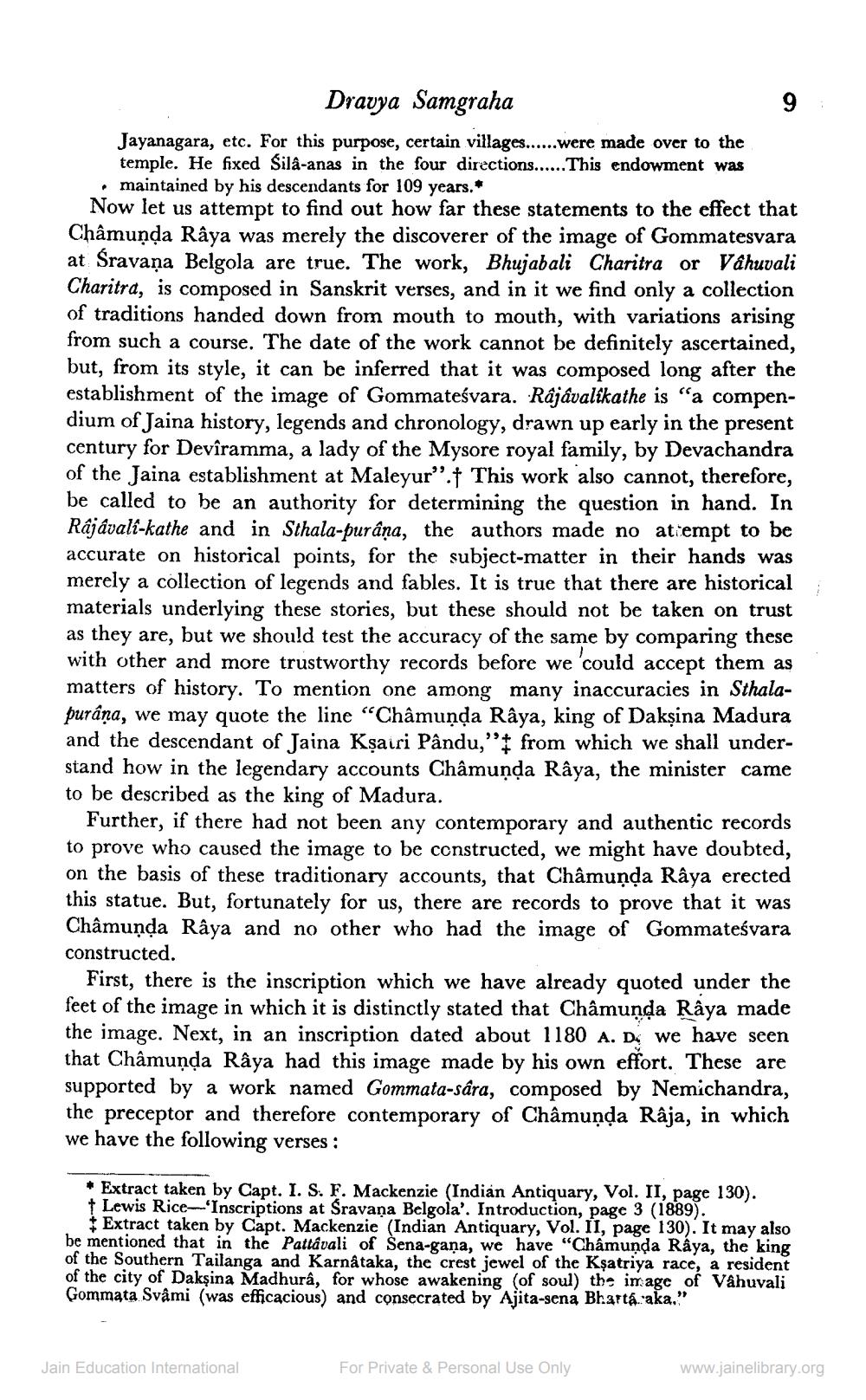________________
9
Dravya Samgraha Jayanagara, etc. For this purpose, certain villages......were made over to the
temple. He fixed Sila-anas in the four directions...... This endowment was . maintained by his descendants for 109 years.* Now let us attempt to find out how far these statements to the effect that Châmunda Râya was merely the discoverer of the image of Gommatesvara at Śravaņa Belgola are true. The work, Bhujabali Charitra or Vâhuvali Charitra, is composed in Sanskrit verses, and in it we find only a collection of traditions handed down from mouth to mouth, with variations arising from such a course. The date of the work cannot be definitely ascertained, but, from its style, it can be inferred that it was composed long after the establishment of the image of Gommateśvara. Rájávalikathe is "a compendium of Jaina history, legends and chronology, drawn up early in the present century for Devîramma, a lady of the Mysore royal family, by Devachar of the Jaina establishment at Maleyur". This work also cannot, therefore, be called to be an authority for determining the question in hand. In Rájávali-kathe and in Sthala-purâna, the authors made no atempt to be accurate on historical points, for the subject-matter in their hands was merely a collection of legends and fables. It is true that there are historical materials underlying these stories, but these should not be taken on trust as they are, but we should test the accuracy of the same by comparing these with other and more trustworthy records before we 'could accept them as matters of history. To mention one among many inaccuracies in Sthalapurâna, we may quote the line “Châmunda Râya, king of Dakșina Madura and the descendant of Jaina Kşairi Pându,"I from which we shall understand how in the legendary accounts Châmunda Râya, the minister came to be described as the king of Madura.
Further, if there had not been any contemporary and authentic records to prove who caused the image to be constructed, we might have doubted, on the basis of these traditionary accounts, that Châmunda Râya erected this statue. But, fortunately for us, there are records to prove that it was Châmunda Râya and no other who had the image of Gommateśvara constructed.
First, there is the inscription which we have already quoted under the feet of the image in which it is distinctly stated that Châmunda Râya made the image. Next, in an inscription dated about 1180 A. D. we have seen that Châmunda Râya had this image made by his own effort. These are supported by a work named Gommata-sära, composed by Nemichandra, the preceptor and therefore contemporary of Châmunda Râja, in which we have the following verses :
* Extract taken by Capt. I. S. F. Mackenzie (Indian Antiquary, Vol. II, page 130). | Lewis Rice-'Inscriptions at Sravana Belgola'. Introduction, page 3 (1889).
Extract taken by Capt. Mackenzie (Indian Antiquary, Vol. II, page 130). It may also be mentioned that in the Pattávali of Sena-gana, we have "Chámunda Raya, the king of the Southern Tailanga and Karnataka, the crest jewel of the Ksatriya race, a resident of the city of Dakşina Madhura, for whose awakening of soul) the image of Vahuvali Gommata Svâmi (was efficacious) and consecrated by Ajita-sena Bharta.aka."
Jain Education International
For Private & Personal Use Only
www.jainelibrary.org




